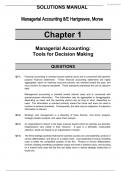Revised 04.20.17
SOLUTIONS MANUAL
Managerial Accounting 8/E Hartgraves, Morse
Chapter 1
Managerial Accounting:
Tools for Decision Making
QUESTIONS
Q1-1. Financial accounting is oriented toward external users and is concerned with general-
purpose financial statements. These financial accounting statements are highly
aggregated, report on relatively long time periods, are oriented toward the past, and
must conform to external standards. These standards emphasize the use of objective
data.
Management accounting is oriented toward internal users and is concerned with
special-purpose information. This information may be aggregated or disaggregated,
depending on need, and the reporting period may be long or short, depending on
need. The information is oriented primarily toward the future and does not need to
conform to external standards. Consequently, the data may be subjective, if subjective
information is relevant.
Q1-2. Strategic cost management is a blending of three themes: cost driver analysis,
strategic position analysis, and value chain analysis.
Q1-3. An organization's mission is the basic purpose toward which its activities are directed.
Organizations vary widely in their missions. A goal is a definable, measurable
objective. Goals are based on an organization’s mission.
Q1-4. The three strategic positions that lead to business success are cost leadership, product or
service differentiation, and focus on a market niche. Cost leadership involves controlling
costs to better the competitive position of the firm. Product or service differentiation
involves creating something considered unique and worth a premium price, and focusing
on a market niche says that the firm can better serve a narrow strategic market than a
broad one.
,Q1-5. With a strategy of cost leadership, an organization is unable to distinguish its product
from that of competitors, and competition is primarily on the basis of price. Careful
budgeting and cost control with frequent and detailed performance reports are critical
for a cost leadership strategy to succeed.
With a strategy of product differentiation, the organization’s products are easily
distinguished from those of competitors, and customers are less sensitive to price. In
this case, while managers must understand the financial consequences of their
actions, frequent and detailed cost information is less important. Instead, costs should
be analyzed from the customer’s viewpoint, and the organization should work closely
with customers to enhance the value of products or services to them.
Q1-6. Planning, organizing, and controlling are referred to as a continuous cycle because the
process of controlling feeds back into the process of planning. Future plans and
organizing to accomplish and implement them are modified on the basis of past
experience. Information on how actual results differ from planned results is provided in
the controlling phase of operations.
Q1-7. Advances in telecommunications to move data, in computers to process data into
information, and in transportation to move products and people have fostered the
move away from isolated national economic systems toward an interdependent global
economy.
Q1-8. Today's competition takes place on the three interrelated dimensions of cost, quality, and
service. Cost includes the purchase price and all subsequent operating and maintenance
costs. Quality is the degree to which products or services meet customer needs. Service
includes such things as the helpfulness of sales personnel, product modifications to
satisfy a particular customer's needs, timely delivery, and subsequent support.
Q1-9. Top management can help to set an ethical tone in the organization by ensuring that
the company has a code of ethics and demonstrating its support for the code, but more
importantly by leading the organization with ethical behavior.
Q1-10. Many ethical dilemmas involve actions that are perceived to have desirable short-run
consequences and highly probable undesirable long-run consequences. The ethical
action is to face an undesirable situation now to avoid a worse situation later. Yet, the
decision maker may prefer to believe that things will work out in the long run, be overly
concerned with the consequences of not doing well in the short run, or simply not care
about the future because the problem will then belong to someone else.
,Q1-11. Activity cost drivers are affected by previous decisions concerning structural and
organizational cost drivers.
• Structural cost drivers result from fundamental decisions about the size and scope
of operations and the technologies employed in delivering products or services to
customers.
• Organizational cost drivers result from choices concerning the organization of
activities and choices concerning the involvement of persons inside and outside
the organization in decision making.
• Activity cost drivers are specific units of work (activities) performed to serve
customers’ needs that consume costly resources.
, MINI EXERCISES
M1-12.
1. l 9. a
2. n 10. d
3. o 11. g
4. e 12. h
5. b 13. j
6. i 14. k
7. c 15. m
8. f
M1-13.
a. Management accounting g. Financial accounting
b. Financial accounting h. Financial accounting
c. Financial accounting i. Financial accounting
d. Management accounting j. Management accounting
e. Management accounting k. Management accounting
f. Management accounting l. Financial accounting
MI1-14
The IMA developed a framework emphasizing the need for management accountants to
partner in planning and decision making, create performance management systems, and
provide expertise in financial reporting and control. See http://www.imanet.org/tools-and-
resources/competency-framework.
Globally, IMA supports the profession through research, the CMA® (Certified
Management Accountant) program, continuing education, networking, and advocacy of
the highest ethical business practices. The IMA’s CMA program focuses specifically on
the competencies required by organizations and CFOs to protect investors and drive
business value. The CMA tests one’s competency in financial planning and analysis, risk
management and internal controls, strategic costing, decision support, performance
management, corporate finance, ethics, and more.





